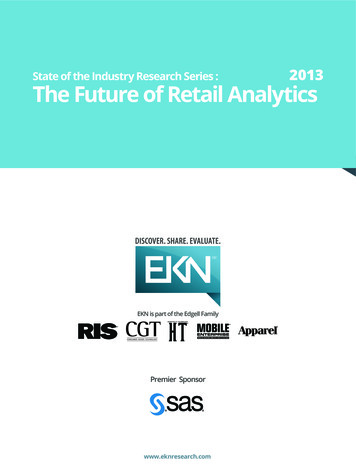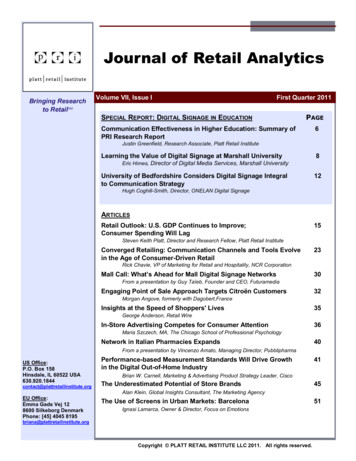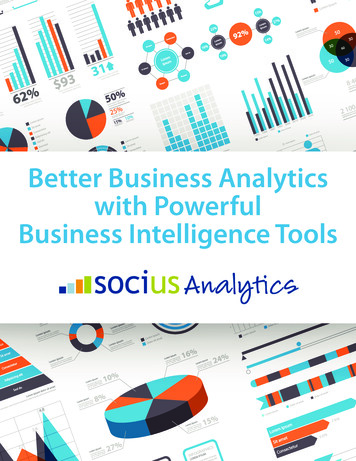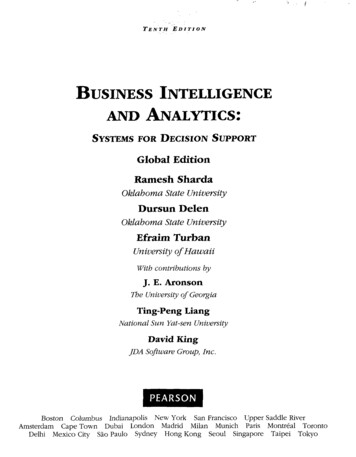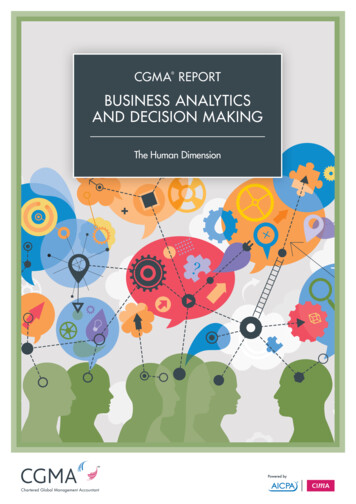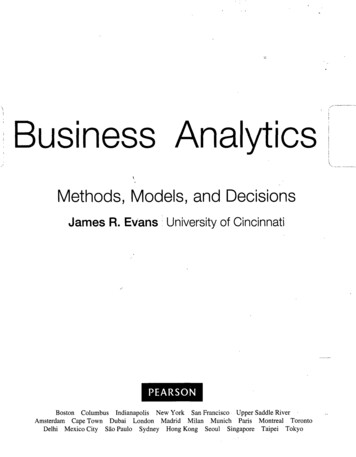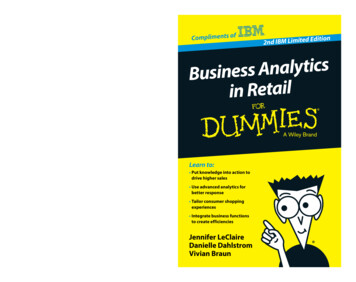
Transcription
Compliments ofGet insights to find newcustomers, keep the onesyou have, and grow profitsBusiness Analytics isn’t a new concept, but newtechnologies are emerging that make it possiblefor average business users to access, analyze,and understand the data required to makedecisions. This book offers principles and toolsyou can use to discover how your customersbehave — and how to put that knowledge intoaction to drive more sales.Open the book and find: The inside scoop on retailanalytics Ways to boost yourcustomer numbers andyour profits How to put BusinessAnalytics to work for youscitylanABusinessin Retail Understand the basics of BusinessAnalytics — know what solutions areavailable to unlock the possibilities ofdiscovery Maximize marketing spend — understandwhat offers segments and individualswill respond toLearn to: Measure consumer sentiment throughsocial media — harness the powerfulinformation in social media today Improve merchandising and assortment —leverage consumer sentiment and historyto better plan assortments Integrate operations into organizationalplanning — align store operations andsales teams with overall strategic goals Put knowledge into action todrive higher salesGo to Dummies.com for videos, step-by-step examples,how-to articles, or to shop! Use advanced analytics forbetter response Tailor consumer shoppingexperiences Integrate business functionsto create efficienciesISBN: 978-1-118-81689-9Not for resaledition2nd IBM Limited EJennifer LeClaireDanielle DahlstromVivian Braun
These materials are 2014 John Wiley & Sons, Inc. Any dissemination, distribution, or unauthorized use is strictly prohibited.
Business Analyticsin Retail2nd IBM Limited Editionby Jennifer LeClaire,Danielle Dahlstrom,and Vivian BraunThese materials are 2014 John Wiley & Sons, Inc. Any dissemination, distribution, or unauthorized use is strictly prohibited.
Business Analytics in Retail For Dummies, 2nd IBM Limited EditionPublished byJohn Wiley & Sons, Inc.111 River St.Hoboken, NJ 07030-5774www.wiley.comCopyright 2014 by John Wiley & Sons, Inc., Hoboken, New JerseyNo part of this publication may be reproduced, stored in a retrieval system or transmitted in anyform or by any means, electronic, mechanical, photocopying, recording, scanning or otherwise,except as permitted under Sections 107 or 108 of the 1976 United States Copyright Act, without theprior written permission of the Publisher. Requests to the Publisher for permission should beaddressed to the Permissions Department, John Wiley & Sons, Inc., 111 River Street, Hoboken, NJ07030, (201) 748-6011, fax (201) 748-6008, or online at http://www.wiley.com/go/permissions.Trademarks: Wiley, For Dummies, the Dummies Man logo, The Dummies Way, Dummies.com,Making Everything Easier, and related trade dress are trademarks or registered trademarks of JohnWiley & Sons, Inc. and/or its affiliates in the United States and other countries, and may not be usedwithout written permission. IBM and the IBM logo are registered trademarks of InternationalBusiness Machines Corporation. All other trademarks are the property of their respective owners.John Wiley & Sons, Inc., is not associated with any product or vendor mentioned in this book.LIMIT OF LIABILITY/DISCLAIMER OF WARRANTY: THE PUBLISHER AND THE AUTHOR MAKENO REPRESENTATIONS OR WARRANTIES WITH RESPECT TO THE ACCURACY ORCOMPLETENESS OF THE CONTENTS OF THIS WORK AND SPECIFICALLY DISCLAIM ALLWARRANTIES, INCLUDING WITHOUT LIMITATION WARRANTIES OF FITNESS FOR APARTICULAR PURPOSE. NO WARRANTY MAY BE CREATED OR EXTENDED BY SALES ORPROMOTIONAL MATERIALS. THE ADVICE AND STRATEGIES CONTAINED HEREIN MAY NOT BESUITABLE FOR EVERY SITUATION. THIS WORK IS SOLD WITH THE UNDERSTANDING THATTHE PUBLISHER IS NOT ENGAGED IN RENDERING LEGAL, ACCOUNTING, OR OTHERPROFESSIONAL SERVICES. IF PROFESSIONAL ASSISTANCE IS REQUIRED, THE SERVICES OF ACOMPETENT PROFESSIONAL PERSON SHOULD BE SOUGHT. NEITHER THE PUBLISHER NORTHE AUTHOR SHALL BE LIABLE FOR DAMAGES ARISING HEREFROM. THE FACT THAT ANORGANIZATION OR WEBSITE IS REFERRED TO IN THIS WORK AS A CITATION AND/OR APOTENTIAL SOURCE OF FURTHER INFORMATION DOES NOT MEAN THAT THE AUTHOR ORTHE PUBLISHER ENDORSES THE INFORMATION THE ORGANIZATION OR WEBSITE MAYPROVIDE OR RECOMMENDATIONS IT MAY MAKE. FURTHER, READERS SHOULD BE AWARETHAT INTERNET WEBSITES LISTED IN THIS WORK MAY HAVE CHANGED OR DISAPPEAREDBETWEEN WHEN THIS WORK WAS WRITTEN AND WHEN IT IS READ.For general information on our other products and services, or how to create a custom For Dummiesbook for your business or organization, please contact our Business Development Department in theU.S. at 877-409-4177, contact info@dummies.biz, or visit www.wiley.com/go/custompub. Forinformation about licensing the For Dummies brand for products or services, contactBrandedRights&Licenses@Wiley.com.ISBN: 978-1-118-81689-9 (pbk); ISBN: 978-1-118-81739-1 (ebk)Manufactured in the United States of America10 9 8 7 6 5 4 3 2 1These materials are 2014 John Wiley & Sons, Inc. Any dissemination, distribution, or unauthorized use is strictly prohibited.
Table of ContentsIntroduction . . . . . . . . . . . . . . . . . . . . . . . . . . . . . . . . . . . . . . 1About This Book. 1Icons Used in This Book. 1Beyond the Book. 2Chapter 1: Understanding the New Consumer. . . . . . . . . 3Retailing in the 21st Century. 4Understanding the Characteristics of Modern Consumers. 5Modern consumers are instrumented. 5Modern consumers are interconnected. 6Modern consumers are intelligent. 6Adapting to the 21st Century Customer. 7Chapter 2: Big Data Meets Business Analytics. . . . . . . . 9Harnessing Data: Variety, Volume, Velocity,and Veracity. 10Identifying retail pain points. 11Asking the critical questions. 11Extracting meaning from the mountains. 12Creating an interconnected organization. 12Understanding the Business Analytics Pillars. 13Business intelligence. 13Advanced analytics. 14Performance management. 14The analytical decision management advantage.15Making More Informed and Risk-Aware Decisions. 16Making strategic decisions that set direction. 17Gaining visibility to determine tactical decisions. 17Using real-time information to makeoperational decisions. 17Aligning Outcomes to Your Business Strategy. 18Communicating the value of analytics. 18Aligning around the point of impact. 19Chapter 3: Marketing in a Consumer-Driven Era. . . . . . 21Understanding Consumer Buying Behavior and Trends. 22Leveraging customer data. 22Putting information in context. 23Clicking with consumer communities. 23These materials are 2014 John Wiley & Sons, Inc. Any dissemination, distribution, or unauthorized use is strictly prohibited.
ivBusiness Analytics in Retail For Dummies, 2nd IBM Limited EditionKeeping content in mind. 23From personalization to commerce. 24Looking at Unstructured Data: The New Age ofBusiness Analytics. 24The unstructured data challenge. 25Recognizing the untapped analytics opportunity. 25Customer-Driven Decision Making. 26Content Analytics in Action. 26Understanding Affinities between Products andCustomers. 27Advanced affinity analysis. 27Market basket analysis. 28Understanding customer preferences. 28Anticipating the customer’s next move. 28Improving Retail Promotions. 29Chapter 4: Making Smart MerchandisingDecisions . . . . . . . . . . . . . . . . . . . . . . . . . . . . . . . . . . . . . 31Enabling Merchandising Efficiencies. 32Reconciling Top-Down and Bottom-Up Plans. 33Developing dynamic retail assortments. 33Aligning store-level assortment with demand. 34Creating a Demand-Driven Supply Chain. 35Leveraging Proven Technology. 36Chapter 5: Overcoming Supply Chain Challenges. . . . . 37Gaining Visibility across the Supply Chain. 38Resolving Operations Problems Before They Arise. 38Collaborating with Vendors. 39Chapter 6: Managing Your Brand to Drive Loyalty. . . . . . 41Building Brand Loyalty in a Digital Age. 42Overcoming Brand Loyalty Building Challenges. 43Making Sense of the Data Explosion. 44Meeting the Needs of Empowered Consumers. 44The rise of mobile commerce. 45Realizing ROI on marketing dollars. 45Building trust with consumers. 46Chapter 7: Managing Store Performance. . . . . . . . . . . . 47Integrating Stores in the Planning Process. 47Identifying ineffective processes. 48Identifying ineffective technologies. 48Discovering a pattern for success. 49Driving better P&L analyses. 50Managing Incentive Compensation. 50These materials are 2014 John Wiley & Sons, Inc. Any dissemination, distribution, or unauthorized use is strictly prohibited.
Table of ContentsvChapter 8: Tapping HR as a Strategic Resource . . . . . . 53Using Analytics to Optimize Staffing Plans. 54Drilling into HR analytics. 54Challenges to implementing analytics remain. 54Determining HR Analytics Signposts. 55Defining the necessary knowledge. 55Evaluating workforce performance. 55Retaining valuable talent. 56Addressing Strategic Human Capital Challenges. 56Determining HR strategies. 56Understanding collaboration andknowledge sharing. 56Putting Your Plans into Action. 57Chapter 9: Generating Revenue Growth . . . . . . . . . . . . . 59Radically Transforming Planning Cycles. 60Designing Practices for Results Analysis. 60Keeping Tabs on KPIs. 61Increasing Overall Performance. 62Chapter 10: Partnering with IT . . . . . . . . . . . . . . . . . . . . . 63Getting the Foundation Right for Business Analytics. 64Moving Fast on Actionable Insights. 65Business and IT Jointly Delivering ContinuousImprovement. 65These materials are 2014 John Wiley & Sons, Inc. Any dissemination, distribution, or unauthorized use is strictly prohibited.
Publisher’s AcknowledgmentsWe’re proud of this book and of the people who worked on it. For details on howto create a custom For Dummies book for your business or organization, contactinfo@dummies.biz or visit www.wiley.com/go/custompub. Fordetails on licensing the For Dummies brand for products or services, contactBrandedRights&Licenses@Wiley.com.Some of the people who helped bring this book to market include the following:Acquisitions, Editorial, and Vertical WebsitesProject Editor: Carrie A. JohnsonAcquisitions Editor: Connie SantistebanEditorial Manager: Rev MengleBusiness Development Representative: Sue BlessingCustom Publishing Project Specialist: Michael SullivanThese materials are 2014 John Wiley & Sons, Inc. Any dissemination, distribution, or unauthorized use is strictly prohibited.
IntroductionData is the key that unlocks greater sales potential forretailers — but the truth is you may be overwhelmedwith so much data that it can seem impossible to make sense(much less value) of continuous information streams. Thisbook offers principles and tools you can use to discover howyour customers behave — and how to put that knowledgeinto action to drive more sales.About This BookBusiness Analytics isn’t a new concept, but new technologiesand capabilities have emerged that make it possible for averagebusiness users — from finance to marketing to merchandisingand beyond — to analyze and understand a plethora of data.If you’re looking to find out how to tap into the power of thesetechnologies to discover insights that, when acted on, driverevenue growth and improve customer relations, this book isfor you. If you work for a consumer product manufacturer thatwants to improve the go-to-market strategy by better understanding consumer behavior or simply wants to achieve greatefficiencies, this book is also for you. Welcome to BusinessAnalytics in Retail For Dummies, 2nd IBM Limited Edition!Icons Used in This BookEvery For Dummies book has small illustrations, called icons,sprinkled throughout the margins. These tiny images callspecial attention to text for one reason or another. Followingare the icons used in this book.These materials are 2014 John Wiley & Sons, Inc. Any dissemination, distribution, or unauthorized use is strictly prohibited.
2Business Analytics in Retail For Dummies, 2nd IBM Limited EditionThe Remember icon highlights points to keep in mind as youimmerse yourself in the world of Business Analytics.Right-on-target information you can use to help make themost of any investment in Business Analytics is next to thisbull’s-eye.The Warning icon does just that — warns. It helps you avoidcommon mistakes, misconceptions, myths, and pitfalls. Besure to look for it so you don’t do more harm than good asyou wade through the world of Business Analytics.Beyond the BookWe recognize that we can’t cover every last detail aboutBusiness Analytics in this book, so if you want to discovermore in-depth information in white papers or case studies, checkout , this helps you further understand how other retailershave tackled the challenges that you face. Or you can visit theURL just for information on events, where to go for assistance,and what useful tips are out there for you.These materials are 2014 John Wiley & Sons, Inc. Any dissemination, distribution, or unauthorized use is strictly prohibited.
Chapter 1Understanding theNew ConsumerIn This Chapter Looking at retailing in the 21st century Understanding and adapting to the characteristics of modernconsumersDo you really know your customers? Do you know whothey are? Do you know how likely they are to buy yourproducts or services? Do you know where they shop and howthey shop? Would you like to know? Retailers who know theircustomers — and apply what they know about their customers’preferences — are finding a competitive advantage in the marketplace. Customers leave footprints — whether they actuallymake a purchase or not. Those footprints are created whencustomers and potential customers browse your website,perform mobile searches, answer surveys, question your staff,contact your call center, and, of course, make purchases. Thosefootprints leave clues about who your customers are, who influences them, what they’re buying, how often and where theyshop, and much more.Much like a detective relies on his trusted evidence collectionkit to solve a case, you can use Business Analytics to gather customer clues that demystify shopping preferences, and apply thoseclues to draw insight and reach conclusions. Business Analyticsincludes the technologies and applications that allow organizations to mine data to glean insights that improve decisionmaking. Indeed, with a clear picture of your customers, you candevelop and deliver a complete offering that consistently reflectsback to them — as they engage with your business — whatthey’ve “told” you they want from you, the retailer.These materials are 2014 John Wiley & Sons, Inc. Any dissemination, distribution, or unauthorized use is strictly prohibited.
4Business Analytics in Retail For Dummies, 2nd IBM Limited EditionIn this chapter, you familiarize yourself with the challengesof retailing in the 21st century, the characteristics ofmodern consumers, and how to adapt your business modelaccordingly.Retailing in the 21st CenturyDigital communication is the new norm for most 21st centuryconsumers. This reality along with the speed of technologicalinnovation and the various types, volume, and speed of consumerdata created today are impacting every industry — but feware feeling the effects more than the retail industry.Think about it for a minute. There’s a social media platformto suit every niche. Online product reviews and recommendations are the new “word of mouth” marketing, with muchgreater reach. Mobile devices are more pervasive than everbefore in history, spanning geographies, social status, anddemographics. New purchasing channels continue emergingand consumers are more empowered and informed abouttheir choices.The result is increased complexity for retailers to accuratelyunderstand customer behavior and purchase patterns,develop meaningful customer segments, predict demand,optimize delivery, protect margins, and drive profitability.Making matters more complex, consumers are demandinga seamless experience from the retailer, regardless of touchpoint, what they need, or how they’re shopping. That makescustomer attainment, retention, and growth more critical yetmore complicated.So, what’s the 21st century retailer to do in this game of survivalof the fittest? Adapt. Indeed, the retailers who best adapt tothe current consumer-driven landscape are the retailers whobuild loyalty and drive the strongest results.These materials are 2014 John Wiley & Sons, Inc. Any dissemination, distribution, or unauthorized use is strictly prohibited.
Chapter 1: Understanding the New Consumer5Understanding the Characteristicsof Modern ConsumersThe IBM Institute for Business Value has identified three characteristics of 21st century consumers. You take a look at thesecharacteristics in this section.Modern consumers areinstrumentedWith the Internet, mobile devices, in-store technologies suchas tablets, and public kiosks — among other continuouslyemerging new technology as well as traditional m arketingmedia — consumers have instant access to a wealth of information about retailers and their products. Consumersare actively using this information to decide what to buy,where to buy, what price to pay, and what payment methodto use. Consumers can shop with a few mouse clicks throughcomparison shopping engines or through online retailers thatcarry the same product from several vendors.Younger consumers, particularly Millenials and Generation X,are especially quick to embrace new technologies to enhancetheir individual shopping experience. Consumers living inemerging markets are even more enthusiastic about tappingtechnology for e-commerce because it opens a world ofshopping choices that were previously unavailable due toeconomic conditions or logistics. As a matter of fact, more than500 million mobile devices are in use that are owned byindividuals who don’t have electricity in their homes and rely onsolar power or village charging stations.Despite this reality, focus can’t completely shift from brick andmortar to digital formats. Keep in mind that consumers usemobile devices for retail purposes that range from finding storesto checking prices and inventory to subscribing to promotionaloffers. At the end of the day, brick-and-mortar stores are still theinstrumented consumer’s primary purchase channel.These materials are 2014 John Wiley & Sons, Inc. Any dissemination, distribution, or unauthorized use is strictly prohibited.
6Business Analytics in Retail For Dummies, 2nd IBM Limited EditionModern consumers areinterconnectedThe ways consumers learn about retailers and productshave radically changed. Once upon a time, retailers were theprimary source of information about their stores and goods.Now, consumers rely surprisingly little on retailers for input.That’s because millions of people around the world are interconnected via social networking sites and read customer comments and product reviews online.In other words, consumers are listening more to other c onsumersthan they are to retailers. Consumers are influencing purchasedecisions of other consumers they don’t even know — andsometimes that sway is happening on a retailer’s own socialnetwork. One-third of the consumers IBM polled are likelyto “follow” a retailer on a social network, chiefly to try newproducts and get preferred customer status. But these sameconsumers will rely on other consumers for information aboutproduct satisfaction.This phenomenon will only grow in the years ahead. Theworld’s population is expected to grow around 12 percentover the next decade, according to United Nations censusdata. More people are now living in cities than rural areas, andhalf of the emerging world’s population is considered middleclass by their country’s standards. The result is a larger poolof more prosperous, more diverse, more technology-savvy,and more demanding consumers.Modern consumers are intelligentConsumers are not only becoming more instrumented andinterconnected, but also they’re intelligent about how toembrace technology for smarter shopping. Today’s consumershave clear ideas about what they want — and what theyexpect — from retailers.In its consumer study, IBM used Max Diff analysis, whererespondents compare different attributes just as they dowhen shopping in real life, to identify what matters most whendeciding where to shop and where they think retailers mostneed to improve. IBM discovered that consumers believeretailers should focus on offering better promotions andThese materials are 2014 John Wiley & Sons, Inc. Any dissemination, distribution, or unauthorized use is strictly prohibited.
Chapter 1: Understanding the New Consumer7prices, and making product improvements. More specifically,consumers want personalized discounts and consistentlyavailable products, followed by better value, quality, andvariety. Nearly two-thirds of consumers also said that theywould spend more money with a retailer if that retailer madethe improvements they suggested and offered a personalizedbrand experience.Adapting to the 21stCentury CustomerIn the game of survival of the fittest, the 21st century retailerneeds to adapt. Indeed, the retailers who best adapt to thecurrent digital media-driven landscape are the retailers whodrive the strongest results, quarter after quarter after quarter.To deal with the challenges and opportunities of the modernretail world, savvy retailers are turning to Business Analytics.Business Analytics isn’t an ancient theory executed by statisticians; it’s a necessary business tool that’s applicable to alldecision makers in the organization to meet the needs ofcustomers and increase their loyalty.Business Analytics helps retailers adapt to this new breed of onsumers in these ways:c Analyzing customer behavior, buying patterns, and sentiment — and responding to their individual needs Delivering personalized promotions for the right productsat the right time and in the customer’s preferred methodin order to motivate purchases Accurately predicting demand in order to optimizeassortment, protect margins, and drive profitability Understanding top customers, how to retain and growthem, and how to develop additional customers Creating a brand experience to build customer loyalty,taking into account the omni-channel approach of manycustomers who want to leverage all channels on theirshopper journeys Gathering information about and analyzing influencersof your customers and understanding how they impactyour customers’ purchasing decisionsThese materials are 2014 John Wiley & Sons, Inc. Any dissemination, distribution, or unauthorized use is strictly prohibited.
8Business Analytics in Retail For Dummies, 2nd IBM Limited EditionThese new retail realities are not only changing the wayretailers conduct business, but also they’re significantlyimpacting the way retail organizations are structured andwhere investments are targeted. For example, runningchannels in silos is more costly for retailers, and it fails toaddress the needs of the omni-channel customer who wantsa consistent and cohesive brand experience whether heresearches or shops online, in a store, at a kiosk, over thephone, or by using a mobile device.Presenting a unified brand experience to the customerdepends on alignment of the customer strategy and accessto the right information across the entire retail organization.This can be a challenge, but it’s one that pays significant dividends. Indeed, this investment in organizational alignmentis critical in the customer’s path to purchase and ultimatelybuilds customer loyalty while staying true to the overarchingcorporate strategy.These materials are 2014 John Wiley & Sons, Inc. Any dissemination, distribution, or unauthorized use is strictly prohibited.
Chapter 2Big Data Meets BusinessAnalyticsIn This Chapter Harnessing the power of information Understanding the components of Business Analytics Coming to informed and risk-aware decisions Aligning business strategies to outcomesImagine harnessing the power of information to create ademand-driven merchandising and supply chain, reducecosts, and drive operational excellence to new heights todeliver a shopping experience that outdoes your competitors.Business Analytics makes that possible.In this fast-paced information age, the need to effectivelymanage and understand information has never been morevital. Retail has always had a lot of data (just think transactionlogs), but now Big Data is entering the scene. An explosionof customer and business information, in a variety of forms,is creating countless challenges for retailers. Consumers aremore connected, more empowered, and more demanding, andthey can choose where, how, and when they want to shop. It’struly a buyer’s market.Forward-thinking retail organizations armed with access to thisdata, and who are able to translate that data into actionableinsights, are turning these challenges into profitable opportunitiesand building customer loyalty. Call it an information-ledtransformation. This change in thinking and approach to dataand insight give retailers the ability to better understand history and what’s happening today to predict future trends.These materials are 2014 John Wiley & Sons, Inc. Any dissemination, distribution, or unauthorized use is strictly prohibited.
10Business Analytics in Retail For Dummies, 2nd IBM Limited EditionIn this chapter, you discover how to harness your data toidentify the pain points that could be impacting your growthand how to extract key information from your data to soothethose pains. You also learn how to make the case for BusinessAnalytics in your organization and begin to align your business strategy to desirable outcomes.Harnessing Data: Variety,Volume, Velocity,and VeracityData is being generated at a rate never before seen in history.Retailers are working to collect, organize, and leverage thatdata appropriately to gain insights that can drive actions and decisions leading to greater customer satisfaction and loyalty,and ultimately impacting bottom-line profits. Business Analyticsmakes that data capture, translation, and next best actionpossible.The current digitization of virtually everything creates newtypes of large and real-time data across a broad range ofindustries. As this book is being written, people are creating2.5 quintillion bytes of data daily across the globe, with17 terabytes coming from Facebook and Twitter alone. Considerthe implications of this statistic: Ninety percent of the data in theworld today has been created in the last two years — andthere are no signs that data creation is going to slow. In fact,the volume and speed at which data is being created willbring new challenges to retailers in the years ahead. Makingmatters more difficult, much of the data is in non-traditionaland unstructured forms. Organizations struggle to establishthe accuracy of much of the data, so they
Go to Dummies.com for videos, step-by-step examples, . Maximize marketing spend — understand what offers segments and individuals will respond to Measure consumer sentiment through social Pmedia — harness the powerful information in so
